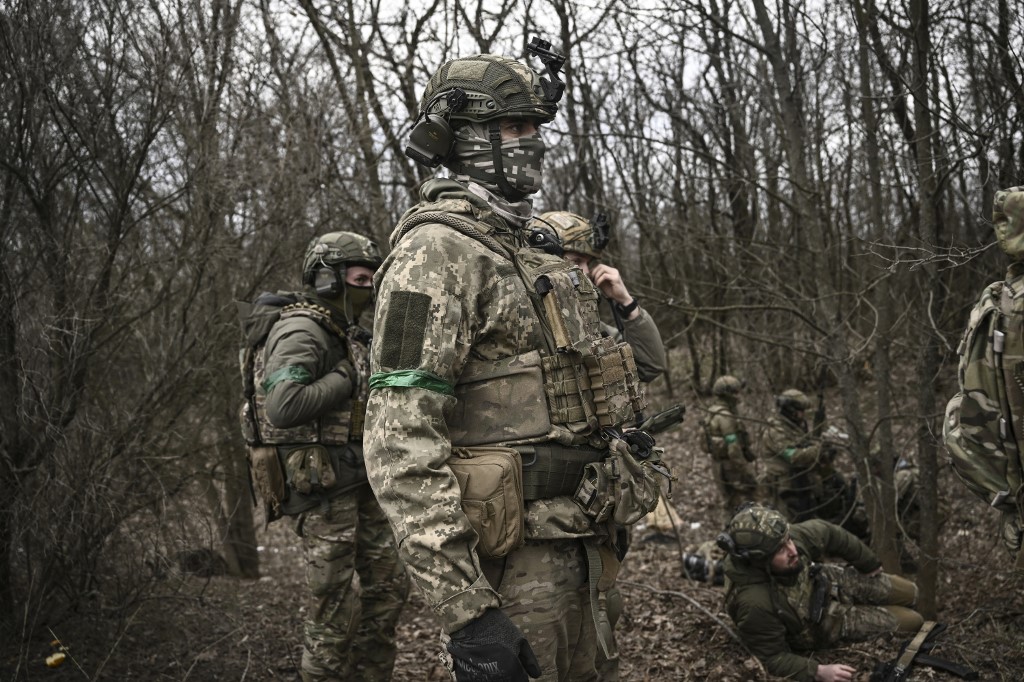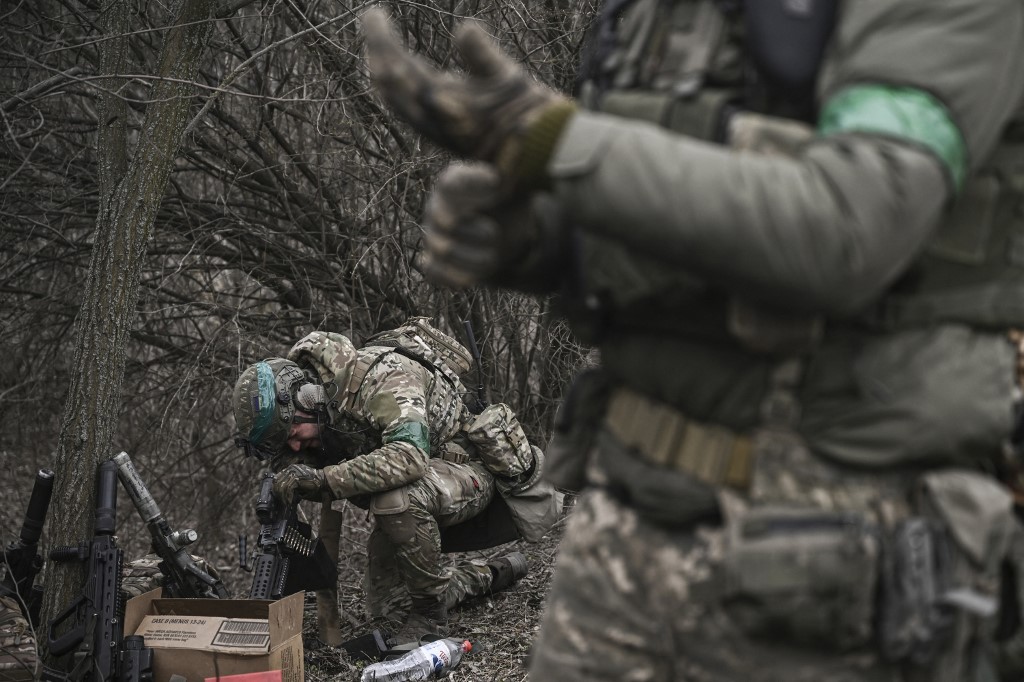
by Emmanuel PEUCHOT
Agence France-Presse
CHASIV YAR, Ukraine (AFP) — Crouched in a small forest, the leader of a Ukrainian commando unit briefs his troops before their mission to counter Russia’s offensive to capture the city of Bakhmut in eastern Ukraine.
The special forces aim to defend the nearby village of Grygorivka in the Donetsk region, about 10 kilometres (six miles) northwest of Bakhmut, which is coming under heavy Russian shelling.
If Moscow’s soldiers and the Russian mercenary group Wagner take the village, it would help them to close pincers around Bakhmut, the centre of the longest and bloodiest battle of the invasion.
“We’re defending positions on the heights near the village. Our mission is to stop the enemy attack and provide artillery support for our infantry,” the commando chief tells AFP, declining to give his name.
Dressed in cagoules and helmets and carrying small camouflage rucksacks, the elite troops are armed with TAR-21 assault rifles — an Israeli design of weapon manufactured under licence in Ukraine.
There is hardly any silence that lasts for more than 10 seconds near Bakhmut. Ukrainian artillery and powerful heavy thuds of nearby Russian shelling constantly ring out.
Just a few kilometres west of Grygorivka, close to the front line, Ukrainian forces “repelled numerous enemy attacks” on the villages of Orikhovo-Vasylivka and Bogdanivka, Ukraine’s General Staff said Thursday morning.
– ‘Difficult situation’ –
“The situation is difficult, but we are in control of it,” the 45-year-old commando chief says during a pause between shells that explode a few hundred metres away.
“We’re able to fight, that’s for sure, but the enemy always has the advantage in terms of artillery. We are suffering losses because of their enormous quantity of artillery. That’s why we are having to move back, but sometimes we advance,” the officer says.
“They are trying to take Bogdanivka, then Chasiv Yar, to close the pocket around Bakhmut,” he adds.
Chasiv Yar, a small town immediately to the west of Bakhmut, is now also under threat from the Russian forces closing their pincers.
This week white phosphorus munitions were fired on Chasiv Yar from Russian positions, setting fire to vegetation in an uninhabited area.
In early January, Russian forces cut off the highway that links Bakhmut to Sloviansk — a large regional hub close to the city of Kramatorsk — and the front has since stabilised.
In the small town of Pryvillya, some two kilometres from the front, a soldier who goes by “Romeo” and commands a Ukrainian post says: “We’re holding this position.”
The Russians “have been pushing for around a week now. They are pushing towards Bakhmut. That’s their priority,” he told AFP.

– Attack drone –
Here, the artillery is quieter and the main activity is drones.
Max, 40, a drone operator nicknamed “Aerobomber”, is sitting alone in his truck next to the road, holding a remote control, his eyes glued to a screen.
He has just launched a small drone loaded with a hand grenade. The drone is flying towards a forest around six kilometres from Russian positions.
On the screen the landscape below is clearly visible. The drone reaches the forest and hovers around 20 metres (65 feet) above the ground.
But close to the objective, Max loses control. The drone drops the grenade and misses.
The Russians “are scrambling the drone, cutting the signal between the drone and the remote control”, he says.
“When the drone loses control, it descends and they fire at it,” the operator explains, after managing to recover his drone bearing scratches from bullets.
He says he lost three drones the day before, taking the total to 62 since the start of the invasion.
“Russia has been preparing for this war for a long time and developed its electronic warfare troops,” says “Zyma”, or winter, the head of a unit of drone operators in southern Ukraine.
Russians use various techniques to drown out the signal to the drone or create a false signal that misdirects it, he says.
“Every one of us does what they can, where they can. Everyone tries to be as effective as possible. This technology allows us to set goals (to kill) 10 Orcs (Russians) per day”, says the “Aerobomber”.
“I feel good, because I see the results of my work. I can use my time and ammo very efficiently. That makes me happy,” he adds.
© Agence France-Presse








